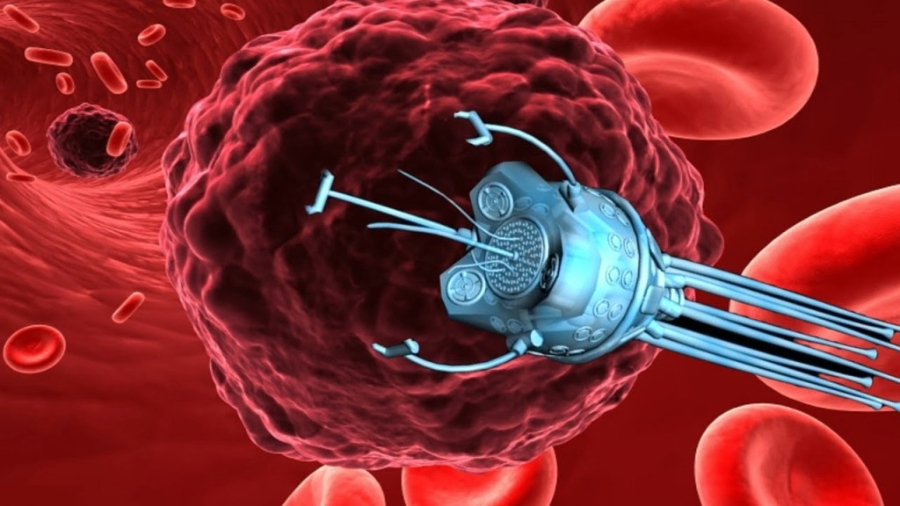Tiny Surgeons of the future
Cancer Fighting Nanobots. Robots have come a very long way over the past few years, and now engineers have developed robots the size of a red blood cell. While these nanorobots won’t necessarily look like spaceships, they will be able to target specific cancerous cells and attack them with precision. Just imagine walking around with tiny robots inside of you.
Microbots: Tiny surgeons of the future
Imagine a world where instead of invasive surgeries, tiny robots, no bigger than a speck of dust, navigate your bloodstream, delivering precise doses of medication directly to diseased cells. This isn’t science fiction, it’s the future of medicine, and it’s called medical micro robotics.
This blog post dives into the fascinating world of these microscopic marvels, exploring their potential to revolutionize healthcare.
From Sci-Fi to Reality
Remember the 1966 movie “Fantastic Voyage”? The miniature submarine crew navigating a scientist’s bloodstream? Well, that fantastical plot is inching closer to reality. Thanks to advancements in physics and biology, scientists are creating microbots capable of entering our bodies and performing intricate tasks.
Tiny Machines, Big Potential:
These microbots aren’t just miniature robots; they’re intelligent machines. They can navigate complex environments, deliver targeted drugs, and even perform delicate surgeries, all within the confines of our bodies.
Imagine:
- Targeted cancer treatment: Microbots could deliver chemotherapy directly to tumor cells, minimizing side effects to healthy tissues.
- Unclogging arteries: Miniature robots could navigate blocked arteries and dissolve clots, preventing heart attacks.
- Fixing brain damage: Microbots could deliver stem cells or drugs to specific areas of the brain, potentially treating neurological disorders like Parkinson’s disease.
Challenges and Solutions
Building these tiny marvels is no easy feat. Scientists face challenges like:
- Miniaturization: Packing all the necessary components, including sensors, motors, and power sources, into a microscopic space is a huge hurdle.
- Biocompatibility: Microbots must be invisible to the immune system, avoiding attacks that could harm both the robots and the patient.
- Navigation and Control: Precisely guiding these microbots within the human body requires sophisticated control systems.
But researchers are making headway. They’re developing:
- Biodegradable materials: These materials allow the microbots to dissolve safely after completing their tasks.
- Camouflage techniques: Coating microbots with biomimetic materials makes them appear like natural parts of the body, fooling the immune system.
- Advanced guidance systems: Magnetic fields, ultrasound, and even light are being used to control and navigate microbots within the body.
The Micro-Revolution: Beyond Disease Treatment
While tackling existing diseases like cancer and heart disease is exciting, medical microrobotics holds potential far beyond just treatment. Let’s explore some other mind-boggling possibilities:
- Enhanced Diagnostics:
Imagine swallowing a microbot capsule coated with bioluminescent markers. As it travels through your digestive system, it maps tissues, detects inflammation, and even identifies precancerous cells, all in real-time. This could revolutionize early diagnosis and preventive healthcare.
- Regenerative Medicine:
Microbots could become tiny construction crews, delivering stem cells and nutrients directly to damaged tissues. Imagine them rebuilding bone after a fracture, repairing cartilage in arthritic joints, or even regenerating nerves after spinal cord injuries.
- Brain-Computer Interfaces:
Microbots could become the bridges between our brains and computers. By interacting with neurons, they could restore lost senses like vision or hearing, or even enhance cognitive abilities for people with neurological disorders.
- Personalized Medicine:
Each of us is unique on a cellular level. Microbots could analyze individual cells, tailoring drug delivery and treatments to our specific genetic makeup and disease progression. This would usher in an era of truly personalized medicine.
- Beyond Humans:
Medical microrobotics aren’t just for humans. Imagine tiny veterinary surgeons repairing injuries in delicate animals or microbots cleaning up environmental pollutants on a microscopic level.
Challenges and Ethical Considerations:
Of course, such advancements come with challenges and ethical questions. Issues like safety, regulatory frameworks, and accessibility need careful consideration. We must ensure that these technologies are used ethically and don’t exacerbate existing inequalities in healthcare access.
The Future is Micro
Medical micro robotics is still in its early stages, but the potential is immense. This technology could revolutionize healthcare, offering minimally invasive, targeted treatments for a wide range of diseases.
So, the next time you swallow a pill, imagine a tiny robot, your microscopic surgeon, embarking on a mission within your body, delivering precise healing right where it’s needed. The future of medicine is small, but its impact will be colossal.
Source

